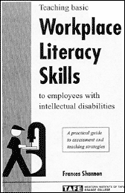The following advice comes from Teaching Workplace Literacy Skills to Employees
with Intellectual Disabilities. The advice is based on answers to the following
two questions:
- What is the best way to teach workplace language, literacy and numeracy
skills to employees with intellectual disabilities?
- What are the particular considerations when teaching employees with intellectual
disabilities?
- Language, literacy and numeracy training should be integrated with other
workplace training.
- When there is meaning and purpose to a task, learning will take place.
- Employees with intellectual disabilities often have difficulty transferring
skills from one learning context to another.
- Tasks should be taught in the context in which they will be performed.
Teaching language, literacy and numeracy skills in isolation from the other
skills used for a particular task will prove less successful.
- People with intellectual disabilities require a systematic approach to
the teaching of skills. Learning needs must be continually assessed. Teaching
must be planned in steps according to needs.
- If a task is broken into steps, it is easier to assess progress toward
a task. Additional teaching can be devoted to problem areas.
- Once a task is learned, constant practice will be necessary for the person
to maintain the skills.

